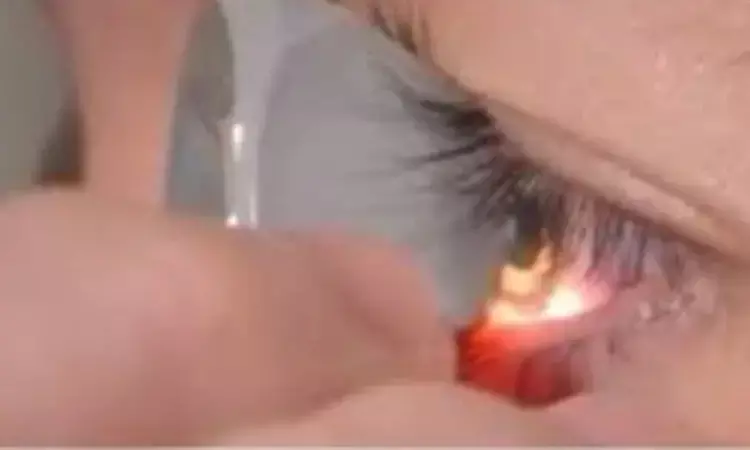- Home
- Medical news & Guidelines
- Anesthesiology
- Cardiology and CTVS
- Critical Care
- Dentistry
- Dermatology
- Diabetes and Endocrinology
- ENT
- Gastroenterology
- Medicine
- Nephrology
- Neurology
- Obstretics-Gynaecology
- Oncology
- Ophthalmology
- Orthopaedics
- Pediatrics-Neonatology
- Psychiatry
- Pulmonology
- Radiology
- Surgery
- Urology
- Laboratory Medicine
- Diet
- Nursing
- Paramedical
- Physiotherapy
- Health news
- Fact Check
- Bone Health Fact Check
- Brain Health Fact Check
- Cancer Related Fact Check
- Child Care Fact Check
- Dental and oral health fact check
- Diabetes and metabolic health fact check
- Diet and Nutrition Fact Check
- Eye and ENT Care Fact Check
- Fitness fact check
- Gut health fact check
- Heart health fact check
- Kidney health fact check
- Medical education fact check
- Men's health fact check
- Respiratory fact check
- Skin and hair care fact check
- Vaccine and Immunization fact check
- Women's health fact check
- AYUSH
- State News
- Andaman and Nicobar Islands
- Andhra Pradesh
- Arunachal Pradesh
- Assam
- Bihar
- Chandigarh
- Chattisgarh
- Dadra and Nagar Haveli
- Daman and Diu
- Delhi
- Goa
- Gujarat
- Haryana
- Himachal Pradesh
- Jammu & Kashmir
- Jharkhand
- Karnataka
- Kerala
- Ladakh
- Lakshadweep
- Madhya Pradesh
- Maharashtra
- Manipur
- Meghalaya
- Mizoram
- Nagaland
- Odisha
- Puducherry
- Punjab
- Rajasthan
- Sikkim
- Tamil Nadu
- Telangana
- Tripura
- Uttar Pradesh
- Uttrakhand
- West Bengal
- Medical Education
- Industry
Laser goniopuncture effective in rescuing eyes after failed deep sclerectomy: Study

UK: A new study in the British Journal of Ophthalmology pointed out that laser goniopuncture (LGP) is a reliable technique to rescue eyes in case of failure of deep sclerectomy (DS). However, the research adds that there are several factors that might affect its success or failure, identifying those factors might help clinicians to predict LGP success.
The study further states that most patients undergoing DS will eventually require LGP.
Intraocular pressure (IOP) control after non‐penetrating deep sclerectomy is the most crucial aspect. Deep sclerotomy acts at the bulk of main resistance to aqueous humor egress. Previous studies have shown laser goniopuncture to be an effective procedure to further lower IOP after DS. Alessandro Rabiolo, Department of Ophthalmology, Gloucestershire Hospitals NHS Foundation Trust, Cheltenham, Gloucestershire, UK, and colleagues aimed to report the incidence, risk factors and long-term outcomes of laser goniopuncture in patients with previous deep sclerectomy.
For this purpose, the authors conducted a retrospective cohort study in 1765 eyes (1385 patients) undergoing DS with or without cataract surgery between 2001 and 2020 in two UK institutions. LGP incidence was estimated using Kaplan-Meier. DS success after LGP was calculated for criteria A, B, and C defined as intraocular pressure (IOP) of ≤18, ≤15 and ≤12 mm Hg with 20%, 25% and 30% reduction, respectively. Cox regression was used to investigate factors associated with the risk of failure.
The results of the study were found to be:
• LGP incidence was estimated and found in 33.3%, 56.3%, and 62.8% at 1st, 3rd, 5th year, respectively.
• Mean IOP was seen to be significantly decreased from 21.2 mm Hg pre-LGP to 13.8 mm Hg and 12.9 mm Hg at 3 and 5 years post-LGP,
• Success rates were seen at 3 and 5 years respectively, 40.9% and 33.7% for criterion A; 27.1% and 22.3% for criterion B and 13.9% and 11.6% for criterion C.
• In all models, it was seen higher pre-LGP IOP and higher pre-LGP medication numbers were associated with increased failure, while male gender, intraoperative mitomycin C, longer interval between DS and LGP with reduced failure.
Rabiolo and the team concluded that " Most patients undergoing DS will eventually require LGP. LGP is effective at rescuing eyes with a failing DS. This study identifies several factors associated with LGP outcomes, knowledge of which may help clinicians predict LGP success."
Reference:
Rabiolo A, Leadbetter D, Kirk J, et alLaser goniopuncture after deep sclerectomy: incidence, long-term outcomes and risk factors for failureBritish Journal of Ophthalmology Published Online First: 20 July 2021. doi: 10.1136/bjophthalmol-2021-319314
Medical Dialogues consists of a team of passionate medical/scientific writers, led by doctors and healthcare researchers. Our team efforts to bring you updated and timely news about the important happenings of the medical and healthcare sector. Our editorial team can be reached at editorial@medicaldialogues.in.
Dr Kamal Kant Kohli-MBBS, DTCD- a chest specialist with more than 30 years of practice and a flair for writing clinical articles, Dr Kamal Kant Kohli joined Medical Dialogues as a Chief Editor of Medical News. Besides writing articles, as an editor, he proofreads and verifies all the medical content published on Medical Dialogues including those coming from journals, studies,medical conferences,guidelines etc. Email: drkohli@medicaldialogues.in. Contact no. 011-43720751


